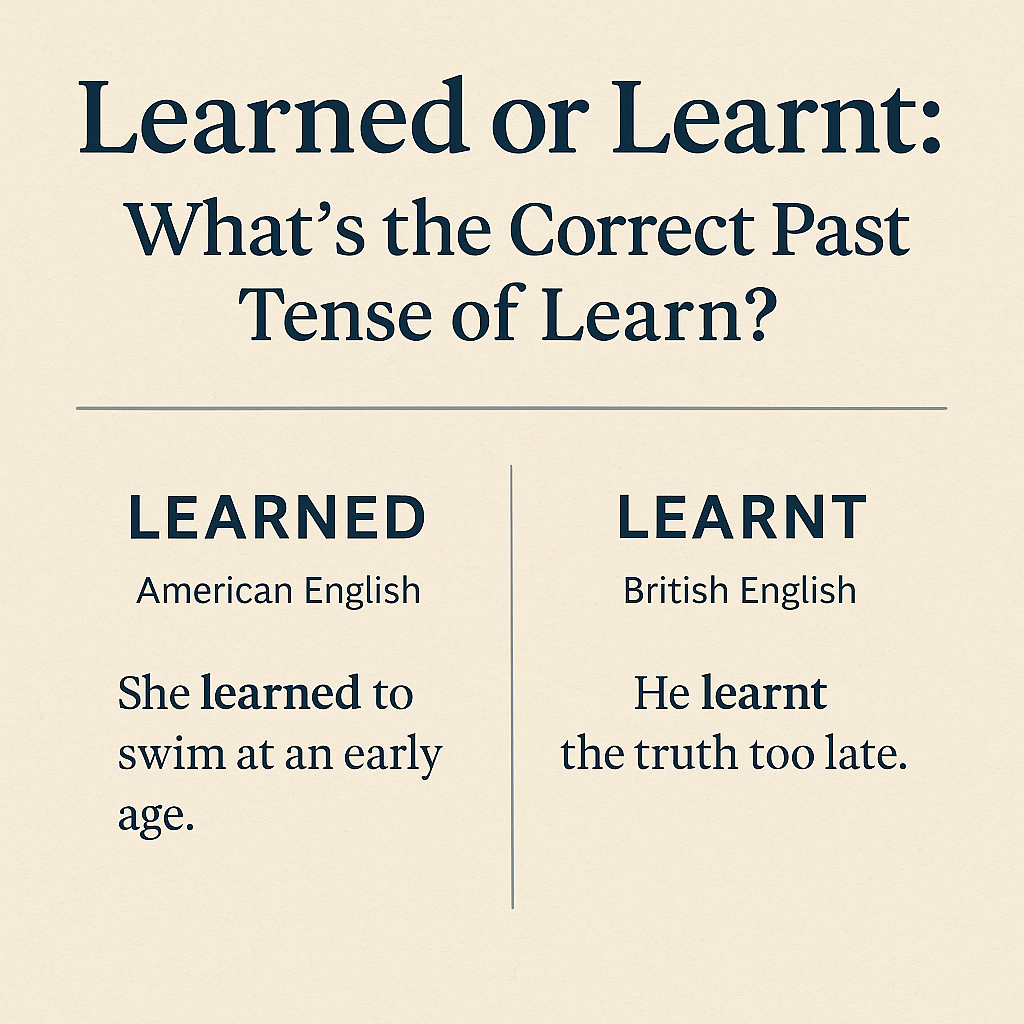Learned or Learnt: Which One Is Correct?

You just finished an essay or a class assignment, and then the question hits you: should it be learned or learnt? Both look right, both sound right, but which one is correct?
The answer depends on where your reader is. If you’re writing for an American audience, learned is the standard past tense of learn. But if your audience is in the UK or another Commonwealth country, you might hear or see learnt more often, especially in everyday speech or informal writing.
Getting these small details right can make your writing feel polished and appropriate for your audience whether it’s for school, a blog, or even an application. In this guide, you’ll learn when to use learned or learnt, how they fit into different styles of English, and the easiest ways to remember which one to choose.
Related post: Compliment or Complement: Praise or Completion?
Explore more: See other confusing word pairs
Grammatical Explanation: Learned or Learnt?
The verb “to learn” means to gain knowledge or acquire a skill. When expressing this action in the past, you have two correct options: learned and learnt.
| Form | Region | Example |
|---|---|---|
| Learned | American English (standard); British English (formal writing) | She learned to swim at an early age. |
| Learnt | British English (informal); used in some Commonwealth countries | He learnt the truth too late. |
Learned is also used as an adjective meaning knowledgeable or well-educated:
- She is a learned scholar in ancient history.
In this case, “learned” (adjective) is pronounced differently: /ˈlɜːrnɪd/.
Examples of Learned or Learnt in Sentences
Correct Usage of Learned (Past Tense of Learn):
- I learned how to drive last year.
- She learned the basics of coding during the course.
- They learned about the changes through the newsletter.
Correct Usage of Learnt (Past Tense of Learn):
- I learnt to bake sourdough bread during the holidays.
- She learnt the news from a friend.
- They learnt valuable lessons from their mistakes.
Incorrect Usage Examples:
Incorrect: He has learnt Spanish fluently, according to the American style guide.
Correct: He has learned Spanish fluently, according to the American style guide.
Incorrect: She learned the skill quickly (if writing for a UK informal audience that expects “learnt”).
Correct: She learnt the skill quickly (British informal context).
Common Mistakes When Choosing Learned or Learnt
The most common mistake is mixing “learned” and “learnt” inconsistently within the same document, especially when writing for an audience with clear regional preferences.
Another mistake is forgetting that learned may also be used as an adjective meaning “well-educated” — which is unrelated to the verb form of learn.
To avoid errors:
- Use learned for American audiences and formal British writing.
- Use learnt in informal British English or Commonwealth writing where appropriate.
- Stay consistent throughout your document.
For style consistency, always check your organisation’s style guide (e.g., APA, Chicago, Oxford).
Memory Tips to Remember Learned or Learnt
Here’s a simple way to keep them apart:
- Learned = American English (always)
- Learnt = British English (often informal)
Mnemonic tip:
In America, they “earned” the “learned.”
In Britain, they “learnt” the ‘t’ casually.
If unsure, and your audience is global, learned is usually the safer option.
Conclusion: Learned or Learnt — Choose with Confidence
Whether you use learned or learnt depends on your audience and the tone of your writing. Both forms are correct as the past tense of learn, but understanding where and how to use them properly keeps your writing clear, polished, and regionally appropriate.
Remember:
- Learned = standard in American English and formal British writing.
- Learnt = informal British English and some Commonwealth regions.
Explore more word pair breakdowns in our spelling confusion series to sharpen your writing.
Related post: Adopted Vs Adapted